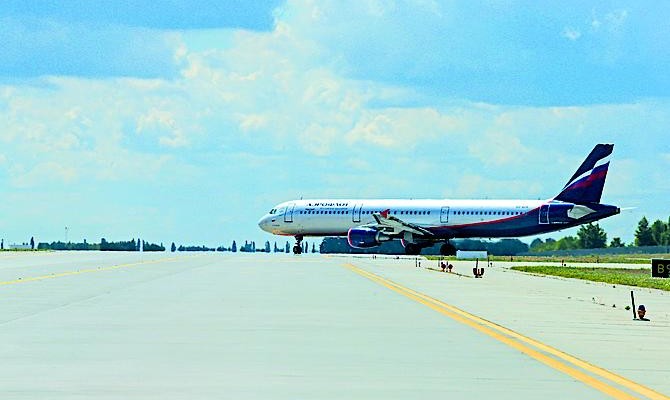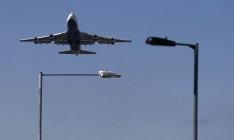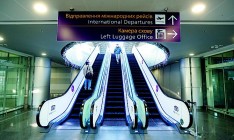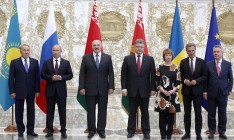Economy
aviationRussian airlines cut flights to mainland Ukraine

Russian airlines refuse to fly to Ukraine. In 2014 the leader of the Russian aviation market – Aeroflot – reduced the number of flights to Ukraine from 72 to 52, according to Aeroflot CEO Vitaliy Savelyev. He also said that previously the carrier planned to increase the number of flights to 98.
Bits of this and that
Aeroflot is not the only Russian airline to reduce the number of flights to Ukraine. The number of flights to Kyiv airports, which are essential for Ukrainian – Russian passenger traffic, was reduced by Transaero – from 31 per week in July last year to 8 in July 2014, S7 – from 12 to 7, UTair – from 23 to 5, according to www.flightmapsanalytics.com. Several airlines have cancelled all flights to Kyiv, namely Rossiya, Orenair, Ak Bars Aero and Yamal Airlines. The head of the analytical service at Aviaport agency (Russia) Oleg Panteleyev says that among Ukrainian destinations only Kyiv was in high demand, while the rest did not have sufficient statistical significance.
The reason for the reduction of the number of flights between Ukraine and Russia, according to General Director of Atlasjet Ukraine airlines Serhiy Pidhorodetskiy, is the reduction of tourist and business traffic flows. The traffic is supported mainly by flights between relatives and friends, he says. Also, since May 2 Ukrainian aviation authorities have banned Russian airlines to fly to airports in Donetsk and Kharkiv.
Russian airlines compensated for the reduction of flights to mainland Ukraine with a sharp increase of the number of flights to Simferopol. According to www.flightmapsanalytics.com, in July last year this airport received an average of 110 flights a week, in July 2014 – more than 310.
It will be possible to assess how this compensation reflected on the financial status of the airlines after they make public their financial statements for the first six months of 2014. “Perhaps, only Aeroflot has a social burden and puts on sale a sufficiently large number of tickets at prices below their prime cost,” says Panteleyev. There are a number of other airlines which provide transportation services subsidized by the government. Yet, at the same time, the number of tickets sold, as a rule, is 20 – 30 in a 150-seat aircraft, which is not much, complains Panteleyev.
Ukrainians are not lagging behind
Ukrainian airlines will be affected by the overall reduction of flights between the two countries more than Russian airlines, said Deputy General Director of the Belarusian airline Belavia Igor Cherginets. “Ukrainian air carriers are less stable than Russian ones,” he explained. According to Corporate Press Secretary of Ukraine International Airlines Yevhenia Satska, while in the summer of 2013 the UIA had 75 weekly flights between Ukraine and Russia, this season it has only 35 flights. For example, from 7 flights to Moscow only 2 remain today. “The Russian direction was important because it generated significant transit passenger flows from regions of Russia to Europe and back,” says Satska. This year, as a result of reduction of traffic volumes the UIA lost close to 40,000 passengers on the Russian direction, specified the interlocutor. In the first six months of 2013 the passenger traffic of the UIA in this direction was approximately 215,000 people, and in 2014 over the same period it was 175,000, she adds. The Russian direction is in first place in terms of passenger traffic for UIA, ahead of such markets as Israel and Egypt.
The UIA could not calculate financial losses from the reduction in passenger traffic in the Russian direction. Satska says by reducing the volumes of carried passengers in all directions in the first half of 2014 the company sustained a loss of more than US $46 mn. The UIA tries to cover its losses by optimizing schedules, transferring aircrafts to leasing, reducing non-operating expenses and optimizing the manpower, concludes Satska.
Even with the end of the anti-terrorist operation there is no guarantee that number of flights will reach the pre-crisis levels, says Pidhorodetskiy, saying the process could drag on for years. If Ukraine and Russia will agree to severance of diplomatic relations, which is now actively being discussed among politicians, passenger traffic may drop even more significantly, he said.
Apparently, Ukrainian airlines are hoping for a positive development of relations in the aviation industry. Pidhorodetskiy says on July 3 the Commission on the Development and Implementation of Public Policy in the Operation of Airways under the Ministry of Infrastructure issued Atlasjet Ukraine a permit for flight operations on the Kyiv – Moscow route with a frequency of 14 times a week. After the company receives the protocol it will need around 45 days to include those flights into the sales system, summarized Pidhorodetskiy.






 of the agreement of syndication with Financial Times Limited are strictly prohibited. Use of materials which refers to France-Presse, Reuters, Interfax-Ukraine, Ukrainian News, UNIAN agencies is strictly prohibited. Materials marked
of the agreement of syndication with Financial Times Limited are strictly prohibited. Use of materials which refers to France-Presse, Reuters, Interfax-Ukraine, Ukrainian News, UNIAN agencies is strictly prohibited. Materials marked  are published as advertisements.
are published as advertisements.